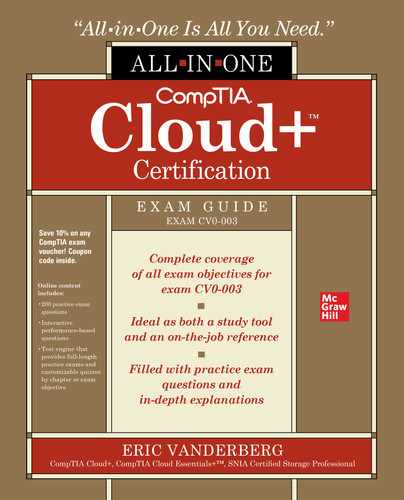CONTENTS
Chapter 1 Cloud Computing Concepts, Models, and Terminology
Accountability and the Shared Responsibility Model
Cloud Deployment Models and Services
On-Premises vs. Off-Premises Hosting
Cloud Characteristics and Terms
Machine Learning and Artificial Intelligence
Exercise 1-1: Creating a Basic Serverless Application on AWS Lambda
Chapter 2 Disk Storage Systems
Redundant Array of Independent Disks (RAID)
Performance Levels of Each Tier
File Allocation Table File System
Exercise 2-1: Formatting a Disk with the NTFS Partition in Windows
Storage Types and Technologies
Exercise 3-1: Creating Object Storage
Internet Fibre Channel Protocol
Internet Small Computer System Interface
Nonvolatile Memory Express Over Fabrics
Chapter 4 Network Infrastructure
Exercise 4-1: Configuring Network Service Tiers in Google Cloud
Network Segmentation and Micro-segmentation
Hypertext Transfer Protocol and Hypertext Transfer Protocol Secure
File Transfer Protocol and FTP over SSL
Secure Shell File Transfer Protocol
Dynamic Host Configuration Protocol
Chapter 5 Virtualization Components
Hardware-Assisted Virtualization
Single Root Input/Output Virtualization
Hyperconverged Systems and Infrastructure
Exercise 5-1: Creating a Virtual Switch in Hyper-V
Exercise 5-2: Creating a Virtual Machine in Hyper-V
Virtualized Infrastructure Service Elements
Chapter 6 Virtualization and the Cloud
Benefits of Virtualization in a Cloud Environment
Network and Application Isolation
Exercise 6-1: Creating a Cloud Firewall on Azure
Exercise 7-1: Creating a Virtual Network in Azure
Exercise 7-2: Creating a Default Route on Azure
Application Feature Use (Increase/Decrease)
Service Account Best Practices
Exercise 8-1: Setting Up SSH Keys for Key-Based Authentication
Continuous Integration/Continuous Delivery
Exercise 9-1: Setting CPU Affinity and Anti-Affinity Rules in VMWare Cloud
Systems Management Best Practices
Exercise 10-1: Configuring Group Policy for Automatic Updates
Collector Protocols and Methods
Verification of Continuous Monitoring Activities
Chapter 11 Security in the Cloud
Effects of Cloud Service Models on Security Implementation
Endpoint Detection and Response
Exercise 11-1: Creating a DLP Policy for Office 365
Impact of Security Tools to Systems and Services
Chapter 12 Security Best Practices
Protecting Against Availability Attacks
Security Governance and Strategy
Developing Company Security Policies
Documenting Security Procedures
Leveraging Established Industry Standards and Regulations
Applying Platform-Specific Security Standards
Exercise 12-1: Creating a Legal Hold for a Mailbox in Office 365
Keeping Employees and Tools Up to Date
Considerations Before You Scan or Test
Chapter 13 Business Continuity and Disaster Recovery
Service-Level Agreements for BCP and HA
Corporate Guidelines/Documentation
Service-Level Agreements for DR
Exercise 13-1: Cross-Region Replication
Chapter 14 Testing, Automation, and Changes
Exercise 14-1: Collecting Windows Metrics with Performance Monitor
Testing in the Cloud Landscape
Runbook Management for Single Nodes
Orchestration for Multiple Nodes and Runbooks
Change and Configuration Management
Exercise 15-1: Using the Google Cloud Policy Troubleshooter
Automation and Orchestration Issues
Appendix B About the Online Content
Your Total Seminars Training Hub Account
